
Glossodoris atromarginata
(Cuvier, 1804)
Order: NUDIBRANCHIA
Suborder: DORIDINA
Family: Chromodorididae
DISTRIBUTION
Found throughout the tropical and subtropical Pacific and Indian Oceans.
PHOTO
Upper: Animal with very folded mantle edge, feeding on one of its food sponges, Hyatella intestinalis, Darwin, Northern Territory, Australia, June 1987. AM C153592. Lower left: Animal with only slighly folded mantle edge and pale brown border, from Heron Island, Great Barrier Reef, Queensland, August, 1979. AM C117260. Lower right: Brown coastal Queensland form, Pelorus Is., Qld. July 1983. AM C138747. Photos: Bill Rudman.
This common species ranges in colour from creamy-white to a pale brown. It is characterized by the black line bordering the very sinuous mantle edge, the black edge to the rhinophore pockets, the black rhinophore clubs and the black edging to the simple gills. The gills often rhythmically wave as the animal crawls along. Specimens can reach 60 mm in length. Although this is the most common species of the group it has been shown recently (Rudman 1986a) that there are a number of almost identically coloured species difficult to separate from G. atromarginata externally.
See also Glossodoris sibogae and Glossodoris cf. atromarginata.
- Rudman, W.B. (1986) The Chromodorididae (Opisthobranchia: Mollusca) of the Indo-West Pacific: the genus Glossodoris Ehrenberg (= Casella, H.& A. Adams). Zoological Journal of the Linnean Society, 86: 101-184.
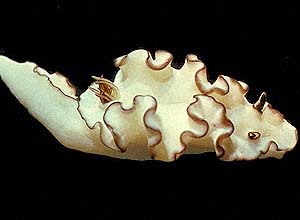
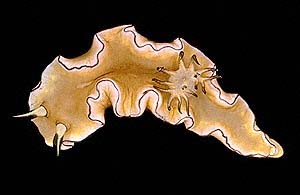
Rudman, W.B., 1998 (April 22) Glossodoris atromarginata (Cuvier, 1804). [In] Sea Slug Forum. Australian Museum, Sydney. Available from http://www.seaslugforum.net/find/glosatro
Related messages
Re: Glossodoris atromarginata - feeding record [1]
November 19, 2009
From: Leanne and David Atkinson

Concerning message #19137:
Hi Bill,
We found this Glossodoris atromarginata on a sponge with its mouth clearly visible. This is quite a common nudibranch in the Port Stephens area but it often has its head pushed into an overgrown area so it is difficult to see what it is feeding on. We were excited to find this one with the mouth parts so clearly visible. There seems to be a small hitchhiker near its rhinophores which it has pulled in.
Locality: The Pipeline, Nelson Bay, Port Stephens, 3metres, New South Wales, Australia, Pacific Ocean, 14 November 2009, Sandy silty bottom with sea pens, sponges, ascidians, gorgonias, soft corals, hydroids and seaweed.. Length: 60 mm. Photographer: Leanne and David Atkinson.
Hope it is of interest.
Regards
Leanne & David Atkinson
atk@hunterlink.net.au

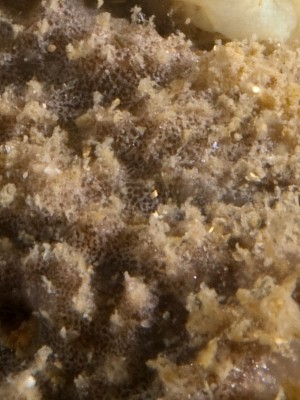

Dear Leanne and David,
Feeding photos are always of interest and we can see how these sponge colonies can often be covered in 'gunk' which often hides their sponge identity.
I am pretty sure this sponge is a thorectid and most probably a species of Semitaspongia.
I can't see the 'hitchhiker' too clearly but the two white structures look like the egg sacs of a copepod crustacean, which may indeed be 'visiting' or living semi permanently on the nudibranch.
Best wishes,
Bill Rudman
Glossodoris atromarginata in the southern Philippines
July 4, 2008
From: Carrie Lo

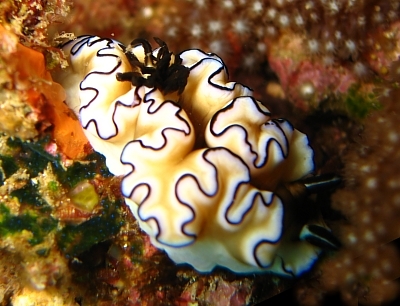
Concerning message #21214:
Dear Bill,
I saw these Glossodoris atromarginata on corals. But the first one is longer, with almost 3 inches long and lighter color in the gills and rhinophores. While the 2nd and 3rd ones looks more round in shape. Both about 2 inches long.
Locality: Sunok, Southern Leyte, 15m, Philippines, 24 Dec 2007. Length: 2-3 inches. Photographer: Carrie Lo.
Cheers,
Carrie
carrielohc@yahoo.com.hk
Carrie Lo, 2008 (Jul 4) Glossodoris atromarginata in the southern Philippines. [Message in] Sea Slug Forum. Australian Museum, Sydney. Available from http://www.seaslugforum.net/find/21572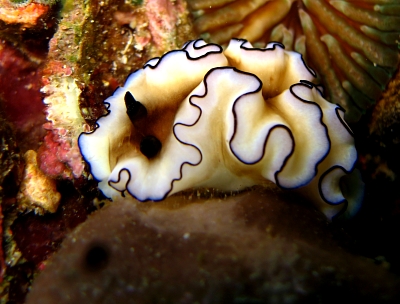
Dear Carrie,
There are a number of species of Glossodoris with this general colour pattern so without an anatomical investigation I couldn't be 100% sure, but I think your photos are all G. atromarginata. This species is one of those with a thick body wall which makes the animal feel quite hard and rigid if you touch it. The difference in shape is just that the animal in your upper photo is stretched out crawling, while the others are 'curled up', resting or perhaps feeding, or investigating possible food sponges. I wouldn't be surprised if the animal in your bottom photo was feeding on the grey-brown sponge it is sitting on. If you look carefully there seems to be a whitish or lighter coloured patch in the centre which could be a feeding scar. I have illustrated a similar feeding scar in an earlier message [#19216]. If you have other photos of this animal whcih show the sponge more clearly I would be interested in seeing them. Possibly you have one in which the slug is slightly out of focus but the sponge is clearer - that would be perfect.
Best wishes,
Bill Rudman
Glossodoris atromarginata laying egg masses
February 27, 2008
From: Toh Chay Hoon
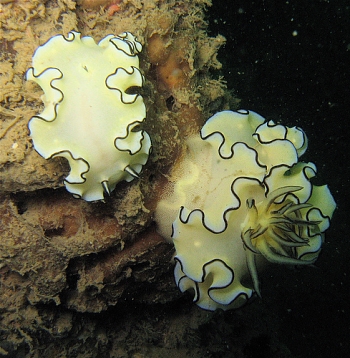
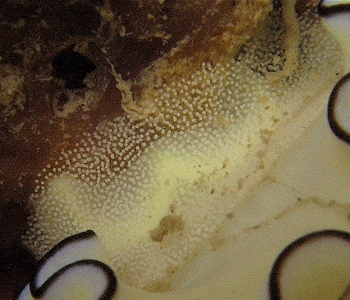
Dear Dr Bill,
I came across this Glossodoris atromarginata laying egg masses on some sponge growing on a jetty pillar while diving at Pulau Hantu, a southern island of Singapore. Beside it was another G. atromarginata. Here are some pics for FYI.
Locality: Pulau Hantu, 10m, Singapore, South China Sea, 30 September 2007, On sponge growing on a jetty pillar. Length: 60mm. Photographer: Toh Chay Hoon.
Toh Chay Hoon
sonnenflower@gmail.com
Toh C.H., 2008 (Feb 27) Glossodoris atromarginata laying egg masses. [Message in] Sea Slug Forum. Australian Museum, Sydney. Available from http://www.seaslugforum.net/find/21214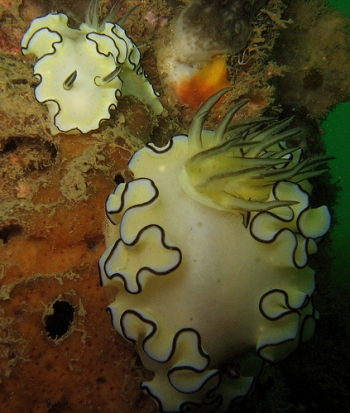
Dear Chay Hoon,
Thanks for this. We have only one photo on the forum of this species' egg ribbon [#8570] so it is good to get another.
Best wishes,
Bill Rudman
Glossodoris atromarginata feeding [2]
June 27, 2007
From: Richard Swann

Hi Bill
A couple more Glossodoris atromarginata feeding from the same day but different dive site [see message #20018 ].
Locality: West Sulug Island, 23meters, Sabah, Borneo, South China Sea, 10th June 2007, Reef slope, outreef. Length: 35mm. Photographer: Richard Swann.
Thanks and best regards
Richard
www.downbelow.co.uk
richard@downbelow.co.uk
Swann, R., 2007 (Jun 27) Glossodoris atromarginata feeding [2]. [Message in] Sea Slug Forum. Australian Museum, Sydney. Available from http://www.seaslugforum.net/find/20019
Thanks Richard,
I agree that this one is definitely feeding but I am afraid I can't positively identify the sponge. All I can say is that it is a sponge which can survive considerable overgrowing by plants, and other animals. Interestingly, this subgroup of the genus Glossodoris have quite a small radula and a long oral tube which could evert as a long thin tube rather than the big inflated bulb seen in species of Hypselodoris, like your nice photos of H. kanga [#19897]. It's possible that the reason we see so little obvious sign of feeding in G. atromarginata, is that the thin oral tube is designed to be able delve deeply into the a sponge colony, partly buried under other growths.
Best wishes,
Bill Rudman
Glossodoris atromarginata feeding [1]
June 27, 2007
From: Richard Swann
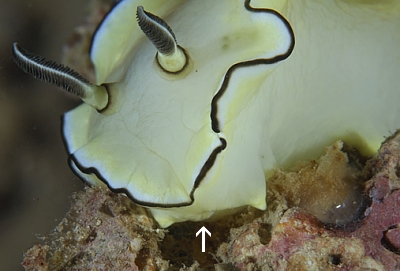

Hi Bill
Here are a few shots of Glossodoris atromarginata feeding !
Locality: Mamutik island,Kota Kinabalu, 17 meters, Sabah, Borneo, South China Sea, 10th June 2007, Reef slope, . Length: 30mm. Photographer: Richard Swann.
I have found Glossodoris spp particularly difficult to get good feeding shots of as they seem to completely hide their food whilst eating.
Hope you find them of use.
Best regards
Richard
www.downbelow.co.uk
richard@downbelow.co.uk
Swann, R., 2007 (Jun 27) Glossodoris atromarginata feeding [1]. [Message in] Sea Slug Forum. Australian Museum, Sydney. Available from http://www.seaslugforum.net/find/20018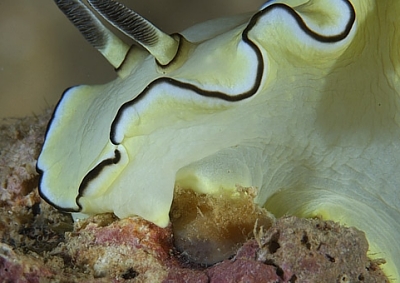
Dear Richard,
I am not sure what - if anything - is happening here. In the upper photo I have put an arrow to show the mouth and there is no sign of a buccal apparatus emerging. The small pointed structures on each side are the small oral tentacles. In the middle photo there is still no sign of any buccal 'activity', and I am not sure why the head/mouth area seem to have swollen up so much. In the lower photo it's possible a thin tube could have everted down into the substrate but I can't see.
All I can suggest in cases like this is to gently nudge the animal and see if it is 'attached' by the feeding apparatus.
Thanks for your interest
Best wishes,
Bill Rudman
Glossodoris atromarginata from Bare Island, Sydney
March 5, 2007
From: Andrew Trevor-Jones
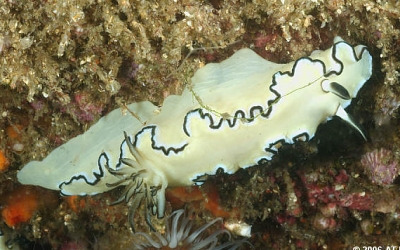
G'day Bill,
Here is a photo of Glossodoris atromarginata from a dive at Bare Island at the end of last year to compare with my photo of G. angasi [message #19555 ]
Locality: Bare Island, La Perouse, Sydney, New South Wal;es, Australia, Pacific Ocean, 30 December 2006, Rocky reef with algae and sponges. 5-7 m. Photographer: Andrew Trevor-Jones.
Andrew.
atj777@attglobal.net
Trevor-Jones, A.G., 2007 (Mar 5) Glossodoris atromarginata from Bare Island, Sydney. [Message in] Sea Slug Forum. Australian Museum, Sydney. Available from http://www.seaslugforum.net/find/19554
Dear Andrew,
Thanks for this photo. It certainly shows the similarity between these two species.
Best wishes,
Bill Rudman
Glossodoris atromarginata - feeding record [1]
January 25, 2007
From: Bill Rudman


Here is more information on one of the animals of Glossodoris atromarginata illustrated on the species Fact Sheet
It was collected in Darwin Harbour feeding on the sponge, Hyatella intestinalis. The sponge was identified by Dr P.R. Bergquist from the sponge specimen.
Locality: Weed Reef, East Arm, Darwin Harbour, 4 m. Darwin, Northern Territory, Australia, 23 June 1987. 48 mm long alive. AM C153592. Photos: Bill Rudman
This animal deserves a place on the abnormalities page - note how the rhinophore pockets are fused into one.
Bill Rudman
Rudman, W.B., 2007 (Jan 25) Glossodoris atromarginata - feeding record [1]. [Message in] Sea Slug Forum. Australian Museum, Sydney. Available from http://www.seaslugforum.net/find/19137Glossodoris atromarginata - feeding record [2]
January 25, 2007
From: Bill Rudman


Here is another record of Glossodoris atromarginata feeding. The sponge has been identified by Dr P.R. Bergquist as Hyatella intestinalis.
Locality: North side Split Solitary Is., Coffs Harbour, New South Wales, Australia, 12-21 m, on dark sponge cream with some darker patches. 18 March 1988. 2 animals - 15, 17 mm long alive AM C155735. Photos: Bill Rudman.
In the lower photo the fibrous skeleton is clearly visible in a section of the sponge that has been eaten.
Bill Rudman
Rudman, W.B., 2007 (Jan 25) Glossodoris atromarginata - feeding record [2]. [Message in] Sea Slug Forum. Australian Museum, Sydney. Available from http://www.seaslugforum.net/find/19216
Glossodoris atromarginata from Sulawesi
December 22, 2006
From: Mike Krampf
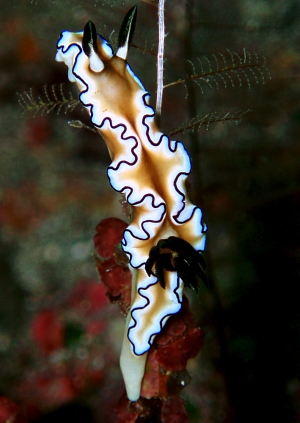
Dear Bill
I didn't see a posting of this species from Indonesia so thought I'd add this picture to your collection.
Locality: Dive Site - Batu Bulan off Siau Island, 55 ft, Sulawesi, Indonesia, Celebes Sea, 24 October 2006, Fringing reef. Length: 4 cm. Photographer: Mike Krampf.
Mike
mtkrampf@yahoo.com
Krampf, Mike, 2006 (Dec 22) Glossodoris atromarginata from Sulawesi. [Message in] Sea Slug Forum. Australian Museum, Sydney. Available from http://www.seaslugforum.net/find/18630Thanks Mike,
Best wishes,
Bill Rudman
Re: Glossodoris atromarginata from Vietnam
July 12, 2006
From: Bruce Wilkie
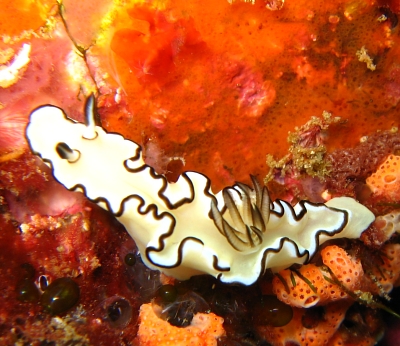
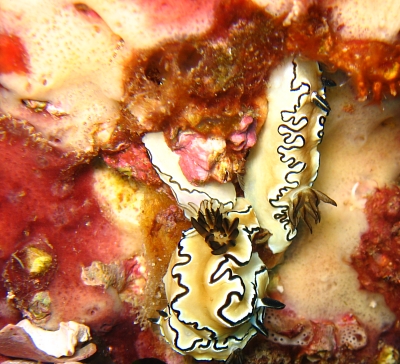
Concerning message #17105:
Hi Bill,
I have been reading Mike`s message [17105] concerning Glossodoris atromarginata and your comments about not having many records of these animals feeding or their association with sponges. These animals are fairly common around here (one or two animals seen on almost every dive), so here are photo`s for your records.
Locality: Upper Photo: Shag Rock, Point Lookout, North Stradbroke Island., 10 metres, Queensland Australia, Pacific Ocean, 30 December 2005, rocky reef with sponges, hard & soft corals . Length: 35mm. Middle Photo: Flat Rock, North Stradbroke Island, 11th December 2005, 14 m, 26 Dec. 2005, Queensland Australia, Pacific Ocean. Lower Photo: Flat Rock, NSI, 19th April 2006, 12mts, 23dec, Queensland Australia, Pacific Ocean. Photographer: Bruce Wilkie.
I hope you can ID the sponges.
Many Thanks,
Bruce Wilkie.
brucedwilkie@yahoo.com.au
Wilkie,B, 2006 (Jul 12) Re: Glossodoris atromarginata from Vietnam. [Message in] Sea Slug Forum. Australian Museum, Sydney. Available from http://www.seaslugforum.net/find/17112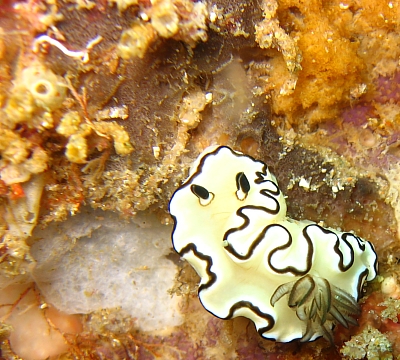
Dear Bruce,
I knew if I continued to be a pain in the neck someone would finally come good. I have found this species a couple of times on branching, 'obvious' sponges but I have never been able to be sure just what G. atromarginata were doing when we found them on apparently featureless, unidentifiable, substrates like this. But in these three photos the sponge is very clear, and in the lower photo we can see a large whitish patch where the slug has eaten out a chunk of the sponge colony. I am pretty sure that the sponge in the three photos is the same species, and as you can see in the upper photos it changes colour from white to almost red, and to greyish purple in the lower photo. I suspect the colour change is due to symbiotic bacteria or algae in its tissue. This is almost ceratinly a sponge of the family Thorectidae and by lucky chance I am meeting my sponge expert next week so will confirm this identification. This is a wonderful find and solves a long term mystery.
Your middle photo also shows the colour variation from almost white to dark brown very well.
Best wishes,
Bill Rudman
Glossodoris atromarginata from Vietnam
July 11, 2006
From: Mike Krampf

He is another pic from Vietnam. It looks similar to Glossodoris atromarginata but the gills and rhinopores are not black so I was sure.
Locality: Three Kings dive site off Whale Island, 50 Ft, North of Nha Trang, Vietnam, South China Sea, 28 June 2006, Rock Pinnacle. Length: 4 cm. Photographer: Mike Krampf.
Thanks as always for your time and insight.
Mike
mtkrampf@yahoo.com
Krampf, M., 2006 (Jul 11) Glossodoris atromarginata from Vietnam. [Message in] Sea Slug Forum. Australian Museum, Sydney. Available from http://www.seaslugforum.net/find/17105
Dear Mike,
This is G. atromarginata. The gills are usually just edged in black as in your photo. You'll notice in the close-up alongside that the gills seem to be near the front of the body, rather than at the back. That is becasue the front half of these animals seem to be burrowed in the substrate, which I suspect is a sponge which they are eating. It is a good illustration of how difficult it can be to get good feeding information for many species. Although common, we have few records of this species feeding or even being associated with a sponge. As your photo shows, I suspect this is not because they are not found with their food sponge, but because their food sponge often doesn't look like a sponge at all.
Best wishes,
Bill Rudman
Glossodoris atromarginata from New Caledonia
February 28, 2006
From: Anthony Delunel

I took this picture in Tenia Island near Boulouparis in New Caledonia - 15 m depth. Is this Glossodoris angasi??
Locality: La Corne - Tenia Island, 15, Nouvelle Caledonie, Coral Sea, 2 October 2005. Photographer: Anthony Delunel.
If not could you help me to put a name on this ?
Thanks a lot
Anthony Delunel
delunel@mls.nc
Delunel, A., 2006 (Feb 28) Glossodoris atromarginata from New Caledonia. [Message in] Sea Slug Forum. Australian Museum, Sydney. Available from http://www.seaslugforum.net/find/15940Dear Anthony,
This is Glossodoris atromarginata. It looks very like G. angasi, but G. atromarginata has a much more rigid body and as you can see in your photo, there is no mantle overlap or 'skirt' around the edge.
Best wishes,
Bill Rudman
Re: Glossodoris atromarginata from Malaysia
December 9, 2003
From: Asther M. Lau
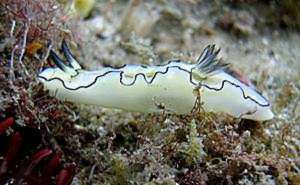
Dearest Bill,
Recently I came back from a fantastic dive at Jarak Island, West Coast of West Malaysia.
Was diving at Whip Garden, at a depth of near 18m while conducting a diving course with a student. The bottom contour were of dead corals, sponges and algae. Found a pair of nudies which I believe should be of Glossodoris atromarginata. (Refer pics I've taken of each). Both were of about 3cm in length only. And each was about 1 meter apart from each other. One was pretty stationery while the other was crawling actively
Strange thing is, just a few centimeter away was another white nudie of about 1.5cm length. Could this be a juvenile? Or of same family? (Lower right photo).
Would appreciate if you can help identify the little white one.
Thank you,
Asther M. Lau
alau425@hotmail.com
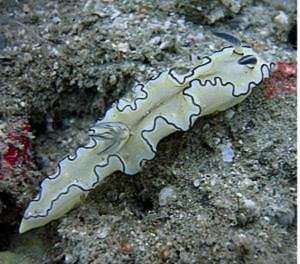

Dear Asther,
The two with black edges to the mantle are Glossodoris atromarginata but the white one is something else. It is almost certainly a species of Glossodoris but jst which one I am not sure. Juveniles sometimes lack colour characters found in adults, which makes identifying juveniles difficult at times. For example it seems to have traces of an opaque white pattern doen the dorsal midline which could indicate it is Glossodoris pallida and it could possibly be Glossodoris misakinosibogae without the black. Basically I am not sure
Best wishes
Bill Rudman
Glossodoris atromarginata mating
October 18, 2003
From: Gary Cobb

Hi Bill,
Attached is a photo of Glossodoris atromarginata mating at the Pinnacles off Mooloolaba, Southern Queensland, Australia. Depth 20m, Size 60mm, Day time, February 3 2003.
This photo was in my archive and I just found it so thought you might like to see it. This species is very common here on the Sunshine Coast, almost every dive you do you can expect to see them.
Cheers
Gary Cobb
gary@cobb.com.au
Cobb, G., 2003 (Oct 18) Glossodoris atromarginata mating. [Message in] Sea Slug Forum. Australian Museum, Sydney. Available from http://www.seaslugforum.net/find/11262Thanks Gary,
Bill Rudman
Glossodoris atromarginata from Hawaii
October 6, 2003
From: Keoki Stender
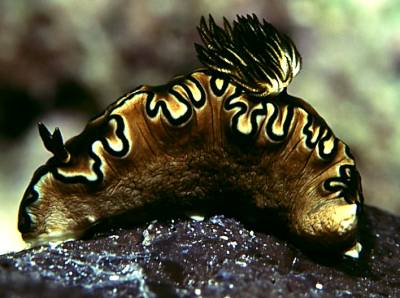
Hi Bill,
Here's a photo of a dark Glossodoris atromarginata found on the large black endemic sponge, Spongia oceania. It is probably the same sponge as the one reported by Pauline Fiene-Severns a few years ago. This photo was taken in April 1995 at Makapu`u, Oahu, Hawaii. There were about 10 individuals seen in the area, all feeding upon this sponge at a depth of 5-8 meters. I have not seen any since then except for one collected in a dead Pocillopora coral at French Frigate Shoals or Maro Reef in September 2002. That specimen was also dark. It is now in the Bishop Museum's collection.
Keoki
fishpicshi@yahoo.com
Stender, K., 2003 (Oct 6) Glossodoris atromarginata from Hawaii. [Message in] Sea Slug Forum. Australian Museum, Sydney. Available from http://www.seaslugforum.net/find/11100Thanks Keoki,
Bill Rudman
Glossodoris atromarginata from Malaysia
July 26, 2003
From: Asther M. Lau

Hi again!
Another one for identification. Thanx!
Location:Lankayan, Sabah, Malaysia
Date: 2nd May 2002
By: Lim Eng Hoo
Asther M. Lau
diveworldwide@yahoo.com
Dear Asther,
This is Glossodoris atromarginata
Best wishes,
Bill Rudman
Glossodoris atromarginata from Taiwan
June 27, 2003
From: Todd Garthwaite
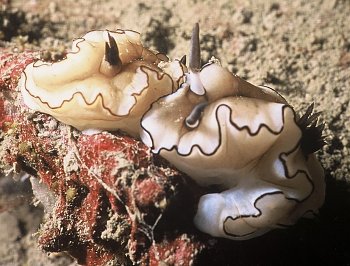
Hi Bill,
Here are several shots of a pair of Glossodoris atromarginata (mating or cuddling perhaps? They were facing opposite directions.), which I came across in a shallower area of the same BaDouZi dive site. This shallower area consists of a lot more hard sponges, silt, and large patches of hard coral, and a lot less sea fans & soft coral.
Site: BaDouZi,(N.E. Coast, Taipei County, Taiwan)
24 May 2003, 10:55am
Depth: 13.7 meters. Water temp.: 24 deg. Celsius. Size: approximately 45-55 mm.
Stay golden.
Todd Garthwaite
typhoontoddy@yahoo.com
Garthwaite, T., 2003 (Jun 27) Glossodoris atromarginata from Taiwan. [Message in] Sea Slug Forum. Australian Museum, Sydney. Available from http://www.seaslugforum.net/find/10218Thanks Todd,
Bill Rudman
Glossodoris atromarginata from Thailand
February 27, 2003
From: Danny Van Belle
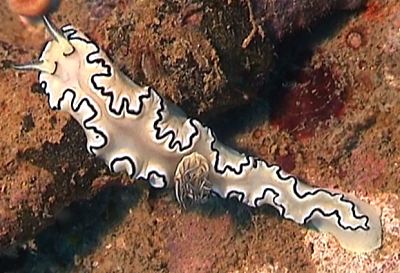
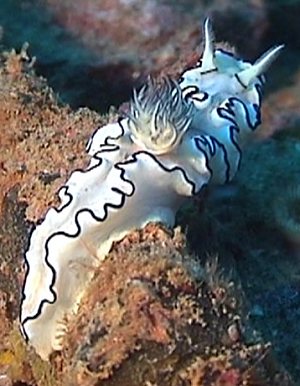
Hi Bill,
Just like the Chromodoris annulata from my earlier messages, these videopictures of Glossodoris atromarginata were taken at the Boonsung wreck, off the west coast of Thailand near Taplamu. [Depth approx 15m - max depth at this divesite is 22 meters.]
The Boonsung wreck is an old tinminer work platform which is like an oasis for marine life as there is nothing else around in this sandy coastline area. A nudibranch paradise!
Best regards
Danny
dannyvb@hotmail.com
Van Belle, D., 2003 (Feb 27) Glossodoris atromarginata from Thailand. [Message in] Sea Slug Forum. Australian Museum, Sydney. Available from http://www.seaslugforum.net/find/9122Thanks Danny,
Bill Rudman
Re: Glossodoris atromarginata
December 21, 2002
From: Danny Van Belle
Hi Bill,
Concernng your question, the two were sitting together but only one was laying an egg ribbon. I have to say that a lot of Glossodoris atromarginata can be found at this divesite and many times in small groups. Thanks for the info on the other ones.
Best regards
Danny
dannyvb@hotmail.com
Van Belle, D., 2002 (Dec 21) Re: Glossodoris atromarginata. [Message in] Sea Slug Forum. Australian Museum, Sydney. Available from http://www.seaslugforum.net/find/8685Thanks Danny,
Bill Rudman
Glossodoris atromarginata with egg ribbon
December 16, 2002
From: Danny Van Belle
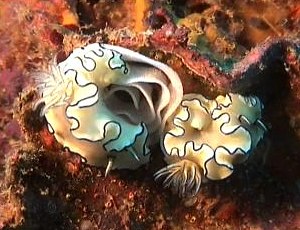
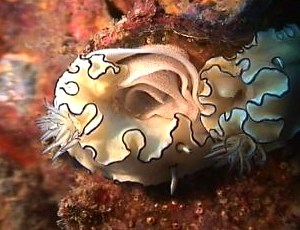
Hi,
A nice shot of Glossodoris atromarginata and egg ribbon.
Divesite : Boonsung wreck, Taplamu, Thailand
Depth: 15m
Danny
dannyvb@hotmail.com
Van Belle, D., 2002 (Dec 16) Glossodoris atromarginata with egg ribbon. [Message in] Sea Slug Forum. Australian Museum, Sydney. Available from http://www.seaslugforum.net/find/8570Thanks Danny,
I must say I have never seen two animals together like this during egg laying. I don't suppose you remember if the one on the right was producing an egg ribbon as well
Best wishes,
Bill Rudman
Glossodoris atromarginata - food sponge?
December 8, 2002
From: Ian Simpson


Dear Bill,
Here is Glossodoris atromarginata from Kurnell [Sydney, NSW, Australia], 2 January 2001; depth 10 metres
Since this shows the specimen on a sponge, and since on the website you discuss there being a number of closely related species that cannot be separated visually, the inclusion of the sponge may be of some interest to you.
Ian Simpson
barts computer@hotmail.com
Simpson, I., 2002 (Dec 8) Glossodoris atromarginata - food sponge?. [Message in] Sea Slug Forum. Australian Museum, Sydney. Available from http://www.seaslugforum.net/find/8600Thanks Ian,
Any clues to these animal's biology and natural history is very welcome. More sightings on the same sponge would be useful, or a photo showing its oral tube everted on the sponge would be good evidence, but we can't always be lucky.
best wishes,
Bill Rudman
Glossodoris atromarginata from Solomon Ids
November 21, 2002
From: Bruce Potter

Bill,
I filmed this Glossodoris atromarginata on 3 November 2002. It was at the Bonegi 2 dive site just outside of Honiara, in the Solomon Islands. It was about 3cm long, and at about 2 meters deep.
Regards,
Bruce Potter.
bruce.potter@adventist.org.sb
Potter, B., 2002 (Nov 21) Glossodoris atromarginata from Solomon Ids. [Message in] Sea Slug Forum. Australian Museum, Sydney. Available from http://www.seaslugforum.net/find/8395Thanks Bruce,
I like the results from your new camera
Bill Rudman
Glossodoris atromarginata from Echizen, Japan
August 13, 2002
From: Nishina Masayoshi
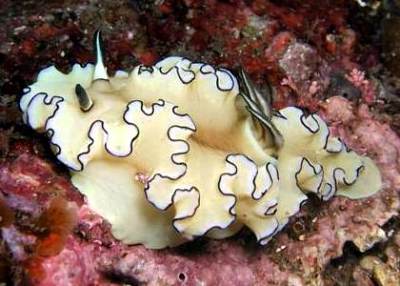
Dear Bill,
This Glossodoris atromarginata was huge. I saw 4 individuals around there and all are more then 90mm!
Date: 3 Aug 2002
Location: Echizen coast, Fukui prif. Japan
Lengh: 90mm
Depth: 6m
Water temp: 27C degree
Photo: M. Nishina
Best Regards,
Nishina Masayoshi
nishina@wips.co.jp


Thanks Nishina,
Bill Rudman
Glossodoris atromarginata from Bintan
August 13, 2002
From: Alice Lee
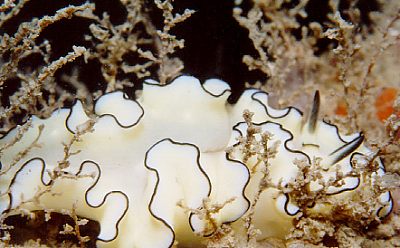
These nudibranch is too big to fit into my framer and it is in a hold, so I can't take a good photo on it.
Depth: 15m
Size: 8cm
Photo taken on 3/8/02 on the Dutch Freighter wreck, north Bintan, Riau Archipelago, Indonesia.
Regards,
Alice
alee@dlink.com.sg
Lee, A., 2002 (Aug 13) Glossodoris atromarginata from Bintan. [Message in] Sea Slug Forum. Australian Museum, Sydney. Available from http://www.seaslugforum.net/find/7723Thanks Alice,
This is Glossodoris atromarginata, which as Nishina Masayoshi reports can sometimes grow even bigger than this.
Best wishes,
Bill Rudman
Glossodoris atromarginata from Taiwan
June 26, 2002
From: Todd Garthwaite
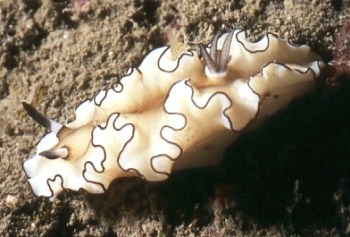
Hi Bill,
Here is a photo of Glossodoris atromarginata, which I came across in an extremely silty area with lots of sponge life, at a dive site called "The Second Wall," just offshore from Fan-Zai Ao. This particular nudibranch was approximately 15 cm. away from another specimen of the same species.
Site: Fan-Zai Ao [Barbarian Cove], N.E. Coast, Taipei County, Taiwan), 15 June, 2002, Depth: 20.8 meters, Temp: 26 degrees C.
Size: Approx. 35mm
Peace, love, & nudis
Todd Garthwaite
(Taipei, Taiwan)
typhoontoddy@yahoo.com
Garthwaite, T., 2002 (Jun 26) Glossodoris atromarginata from Taiwan. [Message in] Sea Slug Forum. Australian Museum, Sydney. Available from http://www.seaslugforum.net/find/7340Thanks Todd,
Bill Rudman
Glossodoris atromarginata from Bali
March 18, 2002
From: Stuart Hutchison
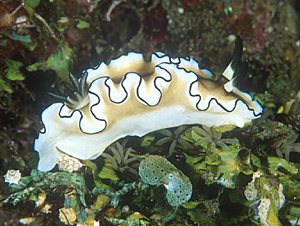
Hi Bill,
Here's Glossodoris atromarginata from Bali, Indonesia on 21 Oct 2001. Depth 15m, length 60mm.
Regards,
Stuart
stuart@stuarthutchison.com.au
Hutchison, S., 2002 (Mar 18) Glossodoris atromarginata from Bali. [Message in] Sea Slug Forum. Australian Museum, Sydney. Available from http://www.seaslugforum.net/find/6308Thanks Stuart,
Bill Rudman
Hong Kong Glossodoris atromarginata
January 24, 2002
From: W.B. Rudman & B.W. Darvell

Here is some information and photos on Glossodoris atromarginata from Brian Darvell's Hong Kong collections.
PHOTO: AM C153708, 11 July 1987, Site 11.181, Duck Rocks (S), Port Shelter, 12 m. Depth range: 1-15 m.., Hong Kong. Photo: Brian Darvell.
Hong Kong Collection Records:
AM C135242,25 July 1982, Site 1.4, Ngo Mei Wan, Crescent Is., Mirs Bay, 8 m. AM C150350, 2 specimens, 4 to 20 April 1986, (Tolo/Mirs Bay). AM C153708, 11 July 1987, Site 11.181, Duck Rocks (S), Port Shelter, 12 m. Depth range: 1-15 m..
Reference:
• Rudman, W.B. & Darvell, B.W. (1990) Opisthobranch molluscs of Hong Kong. Part 1. Goniodorididae, Onchidorididae, Triophidae, Gymnodorididae, Chromodorididae, (Nudibranchia). Asian Marine Biology, 7: 31-79
Best wishes,
Bill Rudman & Brian Darvell
Re: Glossodoris atromarginata in aquaria
January 15, 2002
From: BK
Thanks for your comments on my animal. Instead of trading this creature back to the aquarium store, causing more stress on the creature, what exactly could I feed it if I decide to hold onto it? what kind of sponge would I have to get?
This is the first time my aquarium store was sent this nudibranch and they have asked me to collect as much information as possible on how to care for it.
Thanks,
BK
chess_wizard_1@yahoo.com
BK, 2002 (Jan 15) Re: Glossodoris atromarginata in aquaria. [Message in] Sea Slug Forum. Australian Museum, Sydney. Available from http://www.seaslugforum.net/find/5964Dear BK,
If you look at the continuing correspondence concerning the keeping of Hypselodoris bullocki in aquaria you will see that keeping these animals in almost impossible. Firstly each species feeds on only a few species of sponges, and often we don't know the names of the sponges they feed on. If you look through the Glossodoris atromarginata page you will see photos of a number of sponges which are potential food. So even with one of these photos how is your aquarium shop keeper going to order the correct sponge for you? Even if you have the correct species name it is unlikely that the collectors in the tropical Pacific or Indian Ocean are going to be able to identify the sponge you need. If by a miracle they do find the right sponge then there is the problem of keeping the sponge alive and healthy for the journey to you through at least three middle men. If by another miracle it arrives in good condition you are going to need a sophisticated aquarium systen to keep the sponge alive and healthy. While trying to kep it alive and healthy you will be letting loose on it a nudibranch whose only aim is to scrape big chunks of tissue off it. All in all I would say your chances of success are very slight. And after the Glossodoris has eaten this precious sponge you will need to repeat the process again and again and .....
Is there an alternative food? While replacement foods have been developed for aquarium fish I know of none for specialised invertebrates. I am sorry to sound defeatist, but the important message is to let aquarium shops know that these animals should not be traded. I realise they are passing on what the collectors are passing on up the line of middle men, but the trade will only stop if aquarium shops refuse to buy them.
best wishes,
Bill Rudman
Glossodoris atromarginata in aquaria
January 12, 2002
From: BK
I purchased what I beleve to be a Glossodoris atromarginata from my aquarium store who was told that this nudibranch is an algal grazer (and does not posess toxins), however, on every photograph on this page they are found on or near a sponge. is this species an algae eater, sponge eater, or coral eater? also, what is the typical life span of this creature? is there any thing els I should know about this animal?
I'm also wondering if there is a nudibranch that is a strict algae eater, that is non toxic and will not eat other sessile invertebrates found in home aquariums.
Thanks,
BK
chess_wizard_1@yahoo.com
BK, 2002 (Jan 12) Glossodoris atromarginata in aquaria. [Message in] Sea Slug Forum. Australian Museum, Sydney. Available from http://www.seaslugforum.net/find/5945Dear BK,
The bad news is that the people in your aquarium store don't know what they are talking about. Glossodoris atromarginata is definitely a sponge feeder. All nudibranchs are carnivores, each specialising on a different type of food, usually, but not always colonial or sessile invertebrates. None of them, except for a few special cases, such as Berghia verrucicornis, which eat anemones, are suitable aquarium animals. There are however related herbivorous sea slugs [opisthobranchs] which can live quite happiy in aquaria. Have a look at the pages on Sea Hares for some background information. Another herbivorous slug which seems to be a quite successful aquarium animal is the sacoglossan Elysia crispata. If you have a look at the many messages on that page you should get enough information to think seriously about a herbivorous sea slug rather than a carnivorous nudibranch
Best wishes,
Bill Rudman
Clusters of Glossodoris atromarginata
January 9, 2002
From: Ákos Lumnitzer


Hi Bill,
The first thing I found on our Shark Point dive [north side of Clovelly Bay, Sydney, Australia] yesterday [5 January 2002] was seven Glossodoris atromarginata huddled together. here is a digital still from George Evatt's video (upper right). I've also included a shot I got about four years ago at Bare Island, La Perouse [Sydney] of four specimens congregating.
kind regards
Ákos
dna72@softhome.net
Lumnitzer, A., 2002 (Jan 9) Clusters of Glossodoris atromarginata. [Message in] Sea Slug Forum. Australian Museum, Sydney. Available from http://www.seaslugforum.net/find/5912Dear Ákos,
Thanks for the photos. I suspect that under the weedy growth they seem to be on, is a colony of their food sponge. It likely that their clustering is not so much an act of socialising but a coming together for food. Of course once they are together other things, like mating, may occur. Perhaps next time you see a group like this you could check out whether there is a hidden sponge beneath the weed. If you gently pull a couple of the slugs out of the cluster you may see their mouth parts still extended which would be a good indication of feeding.
Best wishes,
Bill Rudman
Glossodoris atromarginata feeding
January 4, 2002
From: Erwin Köhler

Dear Bill,
Here are some Glossodoris atromarginata feeding. Shot by Georg Heinze, [Georg.Heinze@t-online.de]
Data: size 4-6 cm, depth 12m, May 2001, Negros Oriental Island, divesite "Pier". Philippines,
Erwin
Erwin@medslugs.de
Köhler, E, 2002 (Jan 4) Glossodoris atromarginata feeding. [Message in] Sea Slug Forum. Australian Museum, Sydney. Available from http://www.seaslugforum.net/find/5876Dear Erwin & Georg,
Thanks for this photo. With luck, a sponge expert may be able to give it a name. Photos such as this are proving to be a valuable source of ecological information.
Bill Rudman
Interesting characteristic of G. atromarginata's gills
December 5, 2001
From: Nick Gill
Dr. Rudman,
This probably isn't very inportant to you, but i'd like to mention an interesting habit of Glossodoris atromarginata's cerata. I purchased a specimen out of pity a while ago. It most closely resembles G. atromarginata and is from the Pacific. I observed that it often waves its cerata, even in still water, probably to obtain more oxygen.I'm really sorry I have no pictures of it, but I do not have a digital camera.
P.S I really like your site, because it is so informative, and I often use it to ID nudibranchs I have seen.
Nick Gill
hongqixian@hotmail.com
Gill, N., 2001 (Dec 5) Interesting characteristic of G. atromarginata's gills. [Message in] Sea Slug Forum. Australian Museum, Sydney. Available from http://www.seaslugforum.net/find/5722
Dear Nick,
Thanks for this observation. Species of Glossodoris and Thorunna 'wiggle' their gills rhythmically as you describe. Most nudibranchs have quite thin skins and they probably use the skin as a secondary way to 'breathe' - that is exchange gases between their body and the external environment. It's nice to hypothesise that this wiggling will increase the water flow across the gills but species of Thorunna which are quite small and have 'thin skins' wiggle their gills while much larger, 'thicker skinned' chromodorids don't wiggle their gills. However gill wiggling may work for species of Glossodoris, where many species have quite thick muscular skins so it is unlikely that the body wall is much use as a secondary gill. What is also interesting about species of Glossodoris is that as they get larger, the circle (or horse-shoe) of gills extends at each end into a secondary spiral so greatly increasing the number of gills. Whether these secondary spirals and rhythmic 'wiggling' makes their breathing more efficient would be a very interesting study. In the photos of mine alongside you can see the secondary gill spirals in an adult G. atromarginata and the simple circlet of gills in the juvenile [inset].
Best wishes,
Bill Rudman
Glossodoris atromarginata from Hawaii
September 9, 2001
From: Pauline Fiene-Severns
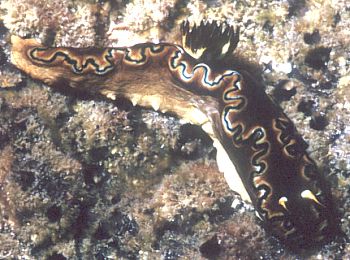
Dear Bill,
I'm sending a photo of a recent find at Molokini Crater in Hawaii. Divemaster Tom Powers spotted it at a depth of 6 feet while guiding snorkelers. It was extremely well camouflaged on a black sponge that we have not identified yet. Despite big surf it remained on the sponge for over a week and so Tom went back and took some photos on July 5, 2001.
If it is Glossodoris atromarginata, as it looks to be, I think it is the first photo ever taken of this species in the main islands of Hawaii (Scott Johnson mentioned seeing a photo taken by somebody else years ago in the Leewards). It is also the darkest color variation I have seen.
Pauline Fiene-Severns
severns@mauigateway.com
Fiene-Severns, P., 2001 (Sep 9) Glossodoris atromarginata from Hawaii. [Message in] Sea Slug Forum. Australian Museum, Sydney. Available from http://www.seaslugforum.net/find/5231Dear Pauline,
Although it's very dark I am sure it is Glossodoris atromarginata. Until you mentioned I hadn't realised that this species was unknown or very rare in Hawaii. I had just assumed it was a ubiquitous Indo-West Pacific species. Thanks for a very interesting find.
Bill Rudman
Glossodoris atromarginata with 4 rhinophores
September 2, 2001
From: Mary Jane Adams

Hi Bill,
Here is a new record for your Abnormalities page. This Glossodoris
atromarginata has almost as many rhinophores as it has gills!
Komodo Island, Indonesia, July 31, 2001.
Best regards,
Mary Jane
divepng@yahoo.com
Adams, M.J., 2001 (Sep 2) Glossodoris atromarginata with 4 rhinophores. [Message in] Sea Slug Forum. Australian Museum, Sydney. Available from http://www.seaslugforum.net/find/5190Thanks Mary Jane,
Another interesting find,
Bill Rudman
Glossodoris atromarginata from Noosa
May 9, 2001
From: C. & C. van der Pennen

We found this nudibranch on a reef off Noosa Heads, southern Queensland, Australia, and would like assistance in identifying it please.
Chris & Carol van der Pennen
keithvdp@a011.aone.net.au
van der Pennen, C. & C., 2001 (May 9) Glossodoris atromarginata from Noosa. [Message in] Sea Slug Forum. Australian Museum, Sydney. Available from http://www.seaslugforum.net/find/4268Dear Chris & Carol,
This is Glossodoris atromarginata.
Best wishes,
Bill Rudman
Glossodoris atromarginata from Sydney
April 13, 2001
From: Erik Schloegl

Dear Bill,
I know that reporting a sighting of Glossodoris atromarginata from Sydney is about as exciting as saying that there's sand in the desert, but perhaps you'll accept this photo as a contribution in the category "pretty picture".
The photo was taken on 7 February 1998, outside Sydney Harbour, just south of the entrance. The depth was 20m.
Best wishes,
Erik
Erik.Schlogl@uts.edu.au
Schloegl, E., 2001 (Apr 13) Glossodoris atromarginata from Sydney. [Message in] Sea Slug Forum. Australian Museum, Sydney. Available from http://www.seaslugforum.net/find/4153Thanks Erik,
I'm always happy to get a pretty picture. Also around Sydney you can be fooled by another very similar looking species, Glossodoris angasi.
Bill Rudman
Information on Glossodoris atromarginata
January 7, 2001
From: Christine Tang
I'm doing reasearch about Glossodoris atromarginata for a marine science project. I've already tried looking through some text books, but I didn't get very much information. I was wondering if I could get some directions on what books I could read or websites to get more information. Please e-mail if you have any information.
Thanks,
Christine
sleepytyger@juno.com
Tang, C., 2001 (Jan 7) Information on Glossodoris atromarginata. [Message in] Sea Slug Forum. Australian Museum, Sydney. Available from http://www.seaslugforum.net/find/3376Dear Christine,
I'm afraid I am not quite sure what information you require. You will get some information on the Glossodoris atromarginata page if you scroll down through the messages. If you want general information on chromodorids [the family it belongs in] then have a look at some of the many species pages listed in the Species List. If you want more general information on dorids and nudibranchs in general then go to the General Topics Index and have a look at some of the relevant pages.
If you have something very specific in mind then perhaps you should send me a question. However, I am afraid we still have a lot to learn about most marine invertebrates.
Good Luck with your project,
Bill Rudman
Re: Samoan nudibranchs
August 31, 2000
From: Don Barclay
Dear Bill,
Many thanks for your comments on the two nudibranchs. The Dendrodoris nigra actually came from a location that is almost completely silt- and sand-free. The north side of Tutuila is mostly black lava cliffs and doesn't have much runoff to put organic material into the water. The visibility in the area was over 50 meters.
We did save a piece of the sponge that the Glossodoris cf. atromarginata was found on, but it looks almost exactly like the sponge in the top photo on your "Glossodoris atromarginata" page. If it isn't Hyatella intestinalis, it must be a closely-related Hyatella species. It was just a bit lighter in color. Larry Madrigal has collected G. atromarginata in Samoa before, but the others were more brightly colored and more distinctly marked, even those that were around the size of this recent specimen.
I didn't take any digital photos of the Chelidonura pallida since we had it positively ID'ed, but Larry says he'll send you a slide of it after they're developed.
Thanks again for all you help.
Cheers,
Don
n5ols@samoatelco.com
Barclay, D., 2000 (Aug 31) Re: Samoan nudibranchs. [Message in] Sea Slug Forum. Australian Museum, Sydney. Available from http://www.seaslugforum.net/find/2945Dear Don,
Thanks for the additional information. My suggestion that they may be from a silty environment must be one of my most short-lived hypotheses. Facts can be a real problem when you have a good theory!
I look forward to a photo of Chelidonura pallida.
Best wishes,
Bill Rudman.
Samoan Glossodoris atromarginata?
August 29, 2000
From: Don Barclay

Hi Bill,
Larry Madrigal and I went diving on the north side of Tutuila, American Samoa today and found a few nudibranchs we hadn't found here before. One slug we found was Chelidonura pallida, which may be a range extension to the east. Another that we found is attached, probably Glossodoris atromarginata, but it doesn't look exactly like any of the photos I've seen. It does seem closer to that species than any other, though. It was about 20mm long when crawling.
This one was collected about one kilometer east of Fagamalo village, northwest Tutuila Island, in 10 to 15 meters of water under rocks on sponge, 3 pm local time, 27 August 2000.
Thanks a lot,
Don
n5ols@samoatelco.com
Barclay, D., 2000 (Aug 29) Samoan Glossodoris atromarginata?. [Message in] Sea Slug Forum. Australian Museum, Sydney. Available from http://www.seaslugforum.net/find/2939Dear Don,
I think this is Glossodoris atromarginata, but there are a number of similarly coloured species which cannot be confidently identified just on photographs. Your animal though, looks quite like a colour form of G. atromarginata which I found in Tanzania. Although this is from the other side of the Indo-West Pacific, I suspect it may represent a coastal colour form, much like the brown-mottled Dendrodoris nigra you collected at the same place.
If you find animals on potential food, like the sponge you mention here, a photo of the sponge is always useful. I realise of course that that is nor always possible. I would also love to see a photo of your Chelidonura pallida.
Other similarly coloured species of Glossodoris include Glossodoris angasi which seems to be restricted to south eastern Australia, and Glossodoris paladentatus which has much much smaller white tubercles and some brownish mottling, but can only be definitively identified by the shape of its most distinctive radular teeth.
Best wishes,
Bill Rudman.
Glossodoris atromarginata? from Brisbane
August 4, 2000
From: Rachel Murphy
Hi Bill
I've been a keen amateur nudibranch student since I took up scuba diving 13 months ago. I like to look for nudibranchs on most dives so I have found your site useful to find information on what I have seen. While I don't have pictures I thought I might contribute my recent findings for general information.
Yesterday (30 July) I was diving at Flinders Reef, Moreton Bay, Brisbane in about 10 m. I found what appears to be Glossodoris atromarginata. Ive found specimens that are more typical in the past. However the one that I found had a marginal colour of yellow-brown on a white/translucent body (similar to a brown variant photographed by Steve Grail - Mooloolaba). The gills and rhinophores were a taupe color with white midline. There was also a fine yellow-brown speckled pattern down the midline of the body and the mantle. Is this just another colour variation of G. atromarginata or do you think it may be another species.
Thanks for the information I've learnt - it certainly makes my diving interesting for days afterwards.
Rachel Murphy.
rachelmurphy_72@hotmail.com
Murphy, R., 2000 (Aug 4) Glossodoris atromarginata? from Brisbane. [Message in] Sea Slug Forum. Australian Museum, Sydney. Available from http://www.seaslugforum.net/find/2802Dear Rachel,
I am afraid that while I may have recently been able to identify species from Florida and Hawaii on brief descriptions, that is only because the species have very distinctive features. I am afraid there are a number of species of Glossodoris which look very similar externally and I would need a photograph for a good guess, and a specimen to confirm it.
Steve Grail's photo is interesting as the animal's shape is like G. atromarginata but the relatively broad colour band at the mantle edge is similar to species such as Glossoris averni.
I have added your details to the Participants List.
Sorry I can't be of more help,
Best wishes,
Bill Rudman.
Glossodoris atromarginata from Western Australia
May 4, 2000
From: Jean-Paul Koninx

Dear Bill,
Here is another photograph from a recent dive trip to the Ningaloo Reef, Exmouth, West Australia.
It was taken at 14m, 'NorthWest Reef', March 30, 2000. It reminds me of Glossodoris atromarginata, but this one is paler and the mantle is rolled up rather than curly. Do you know what it is? The bottom photo shows the same slug in top view.
Thanks!
Jean-Paul Koninx
koninx@ozemail.com.au
Koninx, J-P., 2000 (May 4) Glossodoris atromarginata from Western Australia. [Message in] Sea Slug Forum. Australian Museum, Sydney. Available from http://www.seaslugforum.net/find/2344Dear Jean-Paul,
This is Glossodoris atromarginata. It has quite a variety of colour forms many of which are illustrated on the G. atromarginata page or in the accompanying messages, which are below yours on this page.
Best wishes,
Bill Rudman.
Glossodoris atromarginata from Tanzania
April 1, 2000
From: Bill Rudman.
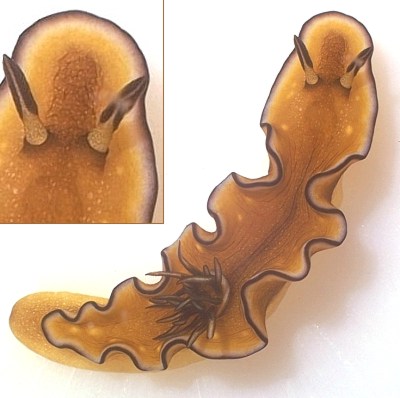
Here is a photo of Glossodoris atromarginata from Tanzania to accompany my comments on Valda Fraser's Glossodoris from South Africa. Note the distinctly yellow-brown background colour and the translucent white speckling.
Details are: Mbegani, 40km N of Dar es Salaam, Tanzania, August 1973, 47mm long alive. PHOTO: Bill Rudman.
Bill Rudman.
Rudman, W.B., 2000 (Apr 1) Glossodoris atromarginata from Tanzania. [Message in] Sea Slug Forum. Australian Museum, Sydney. Available from http://www.seaslugforum.net/find/2182Glossodoris from Bushranger Bay
January 13, 2000
From: Dave Harasti
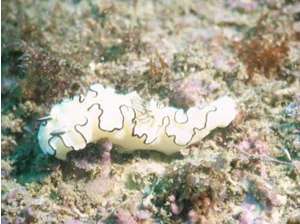
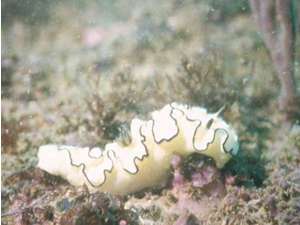
Hi Bill,
I have included 2 images below of a Nudibranch that I'm not sure if it's Glossodoris atromarginata or Glossodoris angasi. It was found in 15 metres of water on a reef wall at Bushranger Bay, Shell Harbour which is just south of Wollongong, New South Wales. Which species is it? (I'm guessing Glossodoris angasi).
I have also placed a collection of some of my Nudibranch photo's on my webpage. I'm still scanning in images so there should be more shortly. The page can be found at http://www2.dynamite.com.au/davidh/Nuddie.html
Dave Harasti
Marine Group
Environment Australia
davidh@dynamite.com.au
Harasti, D, 2000 (Jan 13) Glossodoris from Bushranger Bay. [Message in] Sea Slug Forum. Australian Museum, Sydney. Available from http://www.seaslugforum.net/find/1738Dear Dave,
Your slug is Glossodoris atromarginata. Although G. angasi is endemic to the south eastern Australian coast, the more tropical G. atromarginata is also found in New South Wales when conditions are right. One external difference is that G. angasi usually has only one fold down each side of the mantle.
I look forward to having a look at your website when I get back to Sydney and have more time for 'web surfing'.
Best wishes,
Bill Rudman.
Glossodoris atromarginata from South Africa
November 27, 1999
From: Valda Fraser

Dear Bill
I am responding to Vinka's message on Glossodoris paladentatus. I noticed the distribution indicated. Perhaps this should be amended as I have also seen it along our coast.
Locality: South Coast KwaZulu-Natal, SOUTH AFRICA. Park Rynie - rocky reef - 25m, June 1999. Size: 25mm
Regards
Valda Fraser
iti04937@mweb.co.za
Fraser, V., 1999 (Nov 27) Glossodoris atromarginata from South Africa. [Message in] Sea Slug Forum. Australian Museum, Sydney. Available from http://www.seaslugforum.net/find/1599Dear Valda,
I'm pretty sure your animal is Glossodoris atromarginata rather than G. paladentatus. G. paladentatus has quite distinct brown smudges on the mantle. I hate having to say "trust me" but Glossodoris atromarginata is rather variable in colour and there are a number of very similarly coloured species, of which G. paladentatus is but one. I'm afraid examining the internal anatomy is the only way to be sure. Have a look at another very similarly coloured species, Glossodoris angasi which is endemic to New South Wales and until recently had been considered a colour form of G. atromarginata.
Best wishes,
Bill Rudman.
Glossodoris atromarginata from Philippines
January 15, 1999
From: Erwin Koehler

Here is Glossodoris atromarginata (Cuvier, 1804), BBC, Panglao Is., Philippines, Nov. 1998.
Erwin
E.Koehler@deutschepost.de
Koehler, E., 1999 (Jan 15) Glossodoris atromarginata from Philippines. [Message in] Sea Slug Forum. Australian Museum, Sydney. Available from http://www.seaslugforum.net/find/478Erwin,
This is an interesting view of the head of the animal. The short, but broad and flattened, oral tentacles can be seen on either side of the mouth.
Bill Rudman.
Glossodoris from Mooloolaba
April 22, 1998
From: Wayne Ellis
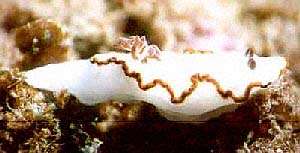
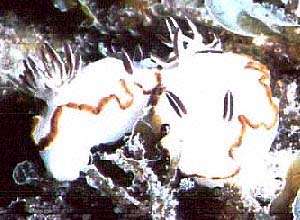
Bill,
Here is another photo from Steve Grail, taken 10-20m, between 1996 -98 off Mooloolaba, Sunshine Coast. It has a brown margin. As far as I know G. atromarginata has a black margin, G. averni has red.
Regards,
Wayne Ellis
glaskin@ozemail.com.au
Ellis, W., 1998 (Apr 22) Glossodoris from Mooloolaba. [Message in] Sea Slug Forum. Australian Museum, Sydney. Available from http://www.seaslugforum.net/find/63I cannot be 100% sure without a specimen to dissect, but I am pretty sure it is a colour form of Glossodoris atromarginata. Although it is usually white with a black margin, some specimens are distinctly yellow with a white band inside the black margin, and some have a brown margin. In some the background colour is also quite brown. Another thing that varies is how "frilly" the edge of the mantle is. In some animals there are only a few folds while in others there are many. The three animals I have illustrated above cover the main variations. You should also be aware that in New South Wales there is another species, Glossodoris angasi which can be easily mistaken for Glossodoris atromarginata
Bill Rudman.
Rudman, W.B., 1998 (Apr 22). Comment on Glossodoris from Mooloolaba by Wayne Ellis. [Message in] Sea Slug Forum. Australian Museum, Sydney. Available from http://www.seaslugforum.net/find/63